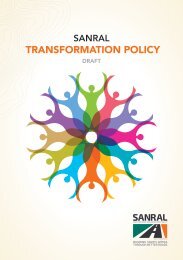Brand-South Africa - Annual report 2015 - 2016
During the past financial year, aligned with its mandate to build pride and patriotism in the Nation Brand, Brand South Africa has worked on initiatives to encourage active citizenship in partnership with its stakeholders in government, business, civil society and identified influential forums to increase the participation of all people, particularly our young people, in building a strong, cohesive Nation Brand. These activities, together with engagements at provincial level on Nation Brand alignment, contribute to social cohesion and a positive Nation Brand. Brand South Africa’s activities took place under the leadership of its new CEO, Amb. Kingsley Makhubela, PhD, who joined the organisation during the year.
During the past financial year, aligned with its mandate to build pride and patriotism in the Nation Brand, Brand South Africa has worked on initiatives to encourage active citizenship in partnership with its stakeholders in government, business, civil society and identified influential forums to increase the participation of all people, particularly our young people, in building a strong, cohesive Nation Brand. These activities, together with engagements at provincial level on Nation Brand alignment, contribute to social cohesion and a positive Nation Brand.
Brand South Africa’s activities took place under the leadership of its new CEO, Amb. Kingsley Makhubela, PhD, who joined the organisation during the year.
Create successful ePaper yourself
Turn your PDF publications into a flip-book with our unique Google optimized e-Paper software.
If <strong>Brand</strong> SA transfers a financial asset in a transfer that qualifies<br />
for derecognition in its entirety and retains the right to service<br />
the financial asset for a fee, it recognise either a servicing<br />
asset or a servicing liability for that servicing contract. If the<br />
fee to be received is not expected to compensate the entity<br />
adequately for performing the servicing, a servicing liability<br />
for the servicing obligation is recognised at its fair value. If<br />
the fee to be received is expected to be more than adequate<br />
compensation for the servicing, a servicing asset is recognised<br />
for the servicing right at an amount determined on the basis<br />
of an allocation of the carrying amount of the larger financial<br />
asset.<br />
If, as a result of a transfer, a financial asset is derecognised<br />
in its entirety but the transfer results in the entity obtaining<br />
a new financial asset or assuming a new financial liability, or<br />
a servicing liability, the entity recognises the new financial<br />
asset, financial liability or servicing liability at fair value.<br />
On derecognition of a financial asset in its entirety, the<br />
difference between the carrying amount and the sum of the<br />
consideration received is recognised in surplus or deficit.<br />
If the transferred asset is part of a larger financial asset and<br />
the part transferred qualifies for derecognition in its entirety,<br />
the previous carrying amount of the larger financial asset is<br />
allocated between the part that continues to be recognised<br />
and the part that is derecognised, based on the relative fair<br />
values of those parts, on the date of the transfer. For this<br />
purpose, a retained servicing asset is treated as a part that<br />
continues to be recognised. The difference between the<br />
carrying amount allocated to the part derecognised and the<br />
sum of the consideration received for the part derecognised<br />
is recognised in surplus or deficit.<br />
If a transfer does not result in derecognition because <strong>Brand</strong><br />
SA has retained substantially all the risks and rewards of<br />
ownership of the transferred asset, <strong>Brand</strong> SA continues to<br />
recognise the transferred asset in its entirety and recognises a<br />
financial liability for the consideration received. In subsequent<br />
periods, <strong>Brand</strong> SA recognises any revenue on the transferred<br />
asset and any expense incurred on the financial liability. Neither<br />
the asset and the associated liability, nor the revenue and the<br />
associated expenses are offset.<br />
Financial liabilities<br />
<strong>Brand</strong> SA removes a financial liability (or a part of a financial<br />
liability) from its statement of financial position when it is<br />
extinguished – i.e. when the obligation specified in the contract<br />
is discharged, cancelled, expires or waived.<br />
An exchange between an existing borrower and lender of debt<br />
instruments with substantially different terms is accounted<br />
for as having extinguished the original financial liability, and<br />
a new financial liability is recognised. Similarly, a substantial<br />
modification of the terms of an existing financial liability, or a<br />
part of it, is accounted for as having extinguished the original<br />
financial liability and having recognised a new financial liability<br />
The difference between the carrying amount of a financial<br />
liability (or part of a financial liability) extinguished or transferred<br />
to another party and the consideration paid, including any noncash<br />
assets transferred or liabilities assumed, is recognised<br />
in surplus or deficit. Any liabilities that are waived, forgiven<br />
or assumed by another entity by way of a non-exchange<br />
transaction are accounted for in accordance with the Standard<br />
of GRAP on Revenue from Non-exchange Transactions (Taxes<br />
and Transfers).<br />
Presentation<br />
Interest relating to a financial instrument or a component that<br />
is a financial liability is recognised as revenue or expense in<br />
surplus or deficit.<br />
Losses and gains relating to a financial instrument or a<br />
component that is a financial liability is recognised as revenue<br />
or expense in surplus or deficit.<br />
A financial asset and a financial liability are only offset and the<br />
net amount presented in the Statement of Financial Position<br />
when the entity currently has a legally enforceable right to<br />
set off the recognised amounts and intends either to settle<br />
on a net basis, or to realise the asset and settle the liability<br />
simultaneously.<br />
In accounting for a transfer of a financial asset that does<br />
not qualify for derecognition, the entity does not offset the<br />
transferred asset and the associated liability.<br />
1.7 Tax<br />
Tax expenses<br />
<strong>Brand</strong> <strong>South</strong> <strong>Africa</strong> is exempt from taxation by the <strong>South</strong> <strong>Africa</strong>n<br />
Revenue Services (SARS) in terms of Section 10(1)(ca)(1) of<br />
the Income Tax Act, 1962 (Act No. 58 of 1962), as amended.<br />
1.8 Leases<br />
A lease is classified as a finance lease if it transfers substantially<br />
all the risks and rewards incidental to ownership. A lease<br />
is classified as an operating lease if it does not transfer<br />
substantially all the risks and rewards incidental to ownership.<br />
When a lease includes both land and buildings elements, the<br />
entity assesses the classification of each element separately.<br />
Finance leases – lessee<br />
Finance leases are recognised as assets and liabilities in the<br />
statement of financial position at amounts equal to the fair<br />
value of the leased property or, if lower, the present value of<br />
the minimum lease payments. The corresponding liability to<br />
the lessor is included in the statement of financial position as<br />
a finance lease obligation.<br />
The discount rate used in calculating the present value of the<br />
minimum lease payments is <strong>Brand</strong> SA’s incremental borrowing<br />
rate.<br />
Minimum lease payments are apportioned between the finance<br />
charge and reduction of the outstanding liability. The finance<br />
charge is allocated to each period during the lease term so as<br />
to produce a constant periodic rate of the remaining balance<br />
of the liability.<br />
Any contingent rents are expensed in the period in which<br />
they are incurred.<br />
97











